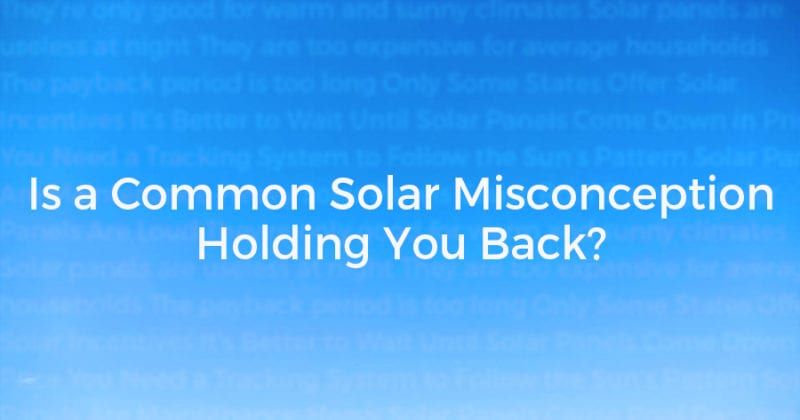Is a Common Solar Misconception Holding You Back?

Solar Power isn’t a new technology. It’s been around for decades and used across a variety of industries. It’s proved itself as a valuable advancement in energy production and has provided users with multiple benefits.
While the idea of solar power is not new, old misconceptions that still surround the technology are preventing some people from choosing to install. We look at some of the most common reasons why you may not be installing solar power, and why you should.
#1. Installing a Solar PV System is expensive
Probably the most common misconception is that solar is expensive. While the initial outlay may seem costly, the truth is solar is the cheapest it’s ever been, and this once-off cost is a solid investment that will save you money in the long-term.
The best way to protect this investment, is to do your research before choosing your solar provider and spend a little more upfront on high quality equipment so you’re not stung with additional costs later on.
Solar panels require very little maintenance and good quality panels will usually have a warranty or life expectancy of 12 - 25 years making them a cost-effective and reliable product.
Payback periods are sitting at around 3-5 years depending on the components and size of your system, and with electricity prices continuing to rise your savings will only improve.
Investing in solar has helped millions of homeowners around Australia save on electricity bills from day one. Peter, a customer based in Perth recently took the plunge, installing a 6.54kW SunPower and Fronius Solar PV System with Infinite Energy. Since installing the system, Peter has seen his electricity bills drop from $350+ to just $10 - a reduction of 97%!
You can learn more about Peter’s decision to install solar here.
#2. Solar power will get more efficient, so I should wait to buy
Solar companies are continuously looking for ways to make their panels perform more efficiently and effectively, however, the potential technological gains of future panels are small compared to the panels ready for installation today.
It’s also important to consider the lifespan of a solar panel. High quality solar panels will still be working effectively 20 years from the day you install, which is considerably longer than most other household appliances.
Some homeowners may also be holding off installing a solar PV system because a better, more efficient renewable technology will come into market in the near future. While renewable technology is always improving, the next big trend in renewable technology are batteries used in support of your PV system.
#3. Placing all your value on feed-in tariffs
A feed-in tariff is the payment you receive for your excess power that your system generated that was exported back to the grid. It will be displayed on your electricity bill as a credit.
The payment should be looked at as a bonus only, however some owners may take this as the only savings factor that your system generated.
Your bill won’t show you how much solar power your system generated, and how much this saved you. It will only show you the excess power that was exported back to the grid, and the amount of energy you used from the grid when your PV system wasn’t generating energy to use (e.g. night time).
Therefore, feed-in tariffs represent a much smaller value compared to what your total solar savings actually are. For a more detailed look at how to effectively calculate your savings, read our blog here.
#4. I won’t live in my home long enough to make my investment in solar back
While installing solar a few years before your plan on selling your home may sound like a pointless exercise, research has proved time and time again that investing in solar increases the value of your home.
A survey conducted by realestate.com.au found that 85% of Australians identify solar rooftop panels as a factor that adds to a property’s value. In addition, they discovered three quarters of renters said they would pay additional rent to live in a property with solar energy, with two out of five saying they’d be willing to pay an extra $10 a week.
Due to shifts in attitude towards sustainable living practices and serious cost of living pressures faced by Australian households, particularly for those in WA, homeowners are willing to pay a premium for homes that come with solar already installed.
If you’re considering solar but are worried that it might not be worth the investment if you decide to move – don’t worry. The research shows you’ve gained an asset that will increase the value of your home.
#5. You need a large roof space for solar
Just like other new technologies, solar panels have become smaller and more powerful. High efficiency panels take up less space because they generate more electricity per square metre. New add-on technologies, like voltage optimizers and micro-inverters, also improve the power output of your solar array, while minimizing the effects of shading. Today, most homes have more than enough roof space to provide majority of a household’s electricity needs.
If you’re building a new home, there are some design options you can incorporate to increase your energy output.
#6. Solar only works in sunny, north-facing areas
Regardless of whether it’s cold or cloudy, solar panels still capture the sun’s rays and convert the energy into solar power, they just can’t capture as much on these days when compared to clear, sunny days.
Fortunately, Australia is one of the most sunshine abundant countries. Perth receives on average 3200 hours of sunshine every year, and even Melbourne receives 2200 sunshine hours annually.
Similarly, although lots of north-facing roof space is ideal for positioning your solar panels, you can still maximise the amount of solar power your system will generate by splitting the panels evenly (or close to) between east and west facing roof space to match the direction in which the sun rises and sets.
#7. Solar panels require more energy to manufacture than they produce in their lifetime
While solar panels are considered a form of clean, renewable energy, the manufacturing process does produce some greenhouse gas emissions. It also uses some chemicals that can be toxic. However, considering a standard solar panel lifespan of 30 years, the clean energy produced over this time far outweighs the energy required to manufacture them.
A study by the National Renewable Energy Laboratory conclusively demonstrates that the manufacturing energy cost versus the energy production payback for solar modules is generally less than 4 years.
If this blog has helped to overcome any misconception you may have had and you’re ready to go solar, contact us today for a free, no obligation quote. Otherwise, if there’s any other factors holding you back, we’d love to hear from you to see if we can help.


